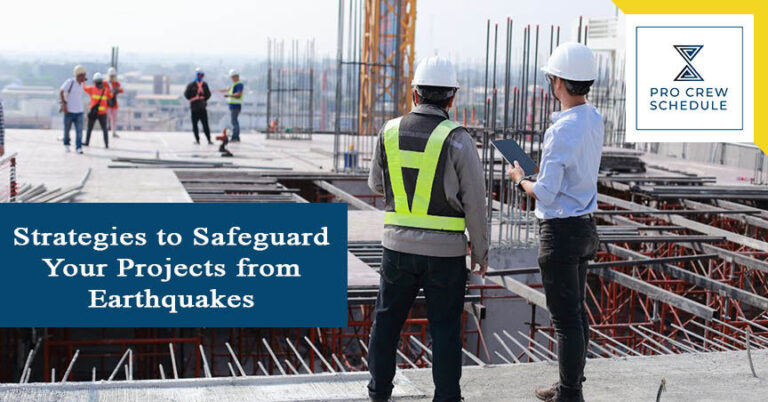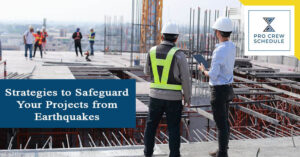Today, managing construction involves taking preemptive measurements to ensure that the buildings constructed will serve communities for many generations. With all the external factors that should be considered during the planning phase, one of the most unpredictable natural calamities the designers spend a lot of time on is earthquakes.
Throughout history, builders have erected impressive structures only to see them succumb to the unforeseeable forces of nature. Earthquakes are one of the planet’s most destructive forces — seismic waves that shake the ground can destroy cities, take lives, and cost huge amounts of money to repair and rebuild.
Architects and structural engineers design earthquake-proof buildings and infrastructures through flexible foundations, shear walls, damping, vibration deflection technology, diaphragms, cross braces, and moment-resisting frames. These innovations are vital for achieving maximum stability and safety for the inhabitants of such buildings.
Unfortunately, earthquakes can happen anytime in earthquake-prone areas — making earthquake-proof buildings a must worldwide. The good news is that engineers have developed new designs and building materials over the past few years to prepare buildings better to withstand earthquakes.
How Can Earthquakes Impact Structures?
Before we look at the components of earthquake-proof buildings, it’s important to understand how earthquakes affect human-made structures. When an earthquake occurs, it sends seismic waves throughout the ground in short but rapid intervals, extending in every direction. While buildings are equipped to handle vertical forces from their dead load and gravity, they cannot typically handle side-to-side forces emitted by these earthquakes.
This horizontal movement vibrates floors, walls, beams, columns, and the braces that hold them together. The difference in movement between the top and the bottom of buildings exerts maximum stress, causing the supporting structural frame to rupture and the building to collapse eventually.
What are Strategies You Can Employ to Earthquake-Proof Your Building?
Engineers work to reinforce the entire structure and counteract the forces of an imaginary earthquake when designing earthquake-proof infrastructure. Since earthquakes release shock waves that push on buildings from one direction, the strategy involves having the buildings push in the opposite direction.
Learn more about how to employ these strategies so you can include them in the planning phase of your construction scheduling software. Here are some of the methods used to help buildings withstand earthquakes.
Establish a Flexible Foundation
One way to withstand ground forces is to “lift” the foundation of the building above the earth through a method known as base isolation. Base isolation means building on top of flexible steel, lead pads, and rubber. Only the isolators vibrate when the base shakes during an earthquake while the structure remains stable. This effectively helps to absorb seismic shock and stop them from traveling through the building.
Counter Earthquake Forces with Damping
If you’ve heard of shock absorbers installed in cars, you might be surprised to learn that structural engineers also use a version of them in earthquake-proof buildings. The same is true for car absorbers; these reduce the shockwaves’ magnitude and help lessen the pressure on the building. This can be accomplished in two ways: pendulum power and vibrational control devices.
a. Pendulum Power
One common damping method is pendulum power, typically used in skyscrapers. To apply this, engineers suspend a large ball from the steel cables that connect to a hydraulic system at the topmost of the building. When the building starts to sway, the ball acts as a pendulum that moves in the opposite direction to stabilize the building.
b. Vibrational Control Devices
This damping method involves placing dampers at each storey of a building between beams and columns. Each damper consists of a piston head inside a cylinder full of silicone oil. When an earthquake transpires, the building transfers the vibrations into the pistons, which work to push against the oil. The vibrational energy is then transformed into heat, dissipating the force of the vibrations. Like pendulum power, these features are tuned to complement and counteract the building’s movement in case an earthquake happens.
Protect Buildings from Vibrations
Instead of just counteracting seismic forces, researchers are experimenting with ways a building can deflect and redirect the energy from earthquakes entirely. Known as the “seismic invisibility cloak,” this construction innovation involves making a cloak of 100 concentric plastic combined with concrete rings and then burying it at least 3 feet below the foundation of the building.
As seismic waves enter the makeshift rings, ease of travel compels them to move through toward the outer rings. Consequently, they are channeled away from the structure and dissipated into the ground.
What Building Materials Can Be Used to Reinforce the Buildings Against Earthquakes?
Construction projects also mean managing the resources that should be utilized as early as the planning phase. To withstand possible collapse, buildings must redistribute seismic forces that travel through them during an event of an earthquake. Some of the materials that can be used to strengthen your building are the following:
- Shear Walls: These act as a building’s backbone and are effective building technologies that can transfer earthquake waves. Made of multiple panels, shear walls help a building keep its form during shaking or movement. Shear walls are usually supported by diagonal cross braces, which are made of steel. These beams can support tension and compression, helping to push forces and counteract pressure.
- Diaphragms: These are a central part of a building’s structural integrity. Consisting of the building’s floors, roof, and decks placed over them, diaphragms can help remove tension from the floors and push forces to the building’s vertical components instead.
- Cross Braces: These are attached to a building’s frame by bracing stud to stud in an X pattern; the role of these braces is to increase load capacity. Cross braces keep buildings stable against seismic activity and high winds.
- Moment-Resisting Frames: Provide extra flexibility in a building’s structural design. These frames are placed among the building’s joints and allow beams and columns to bend while the joints remain solid. Hence, the building can resist the larger forces from an earthquake while allowing designers to re-arrange building elements.
- Earthquake-Resistant Materials: While shock absorbers and pendulums may help dispel the seismic energy to an extent, the chosen building materials are equally responsible for its stability.
- Steel and Timber: These are building materials that can resist vibration and stress. The high ductility components of steel and timber, which can undergo large deformations and tension, make them a good earthquake-resistant material. Modern buildings are typically constructed with structural steel and materials in various shapes and sizes that allow buildings to bend without breaking. Timber is also a ductile building material due to its high strength parallel to its lightweight structure.
- Shape Memory Alloys: are innovative materials that scientists and engineers are developing for new building materials. Shape memory alloy provides even greater shape retention, can endure heavy strain, and revert to its original shape.
- Fiber-Reinforced Plastic Wraps: These are made from various polymers. They can be wrapped around columns and provide up to 38% added ductility and strength.
- Sustainable Building Materials: Structural engineers also turn to sustainable construction to help reinforce buildings. The strength-to-size ratio of spider silk and the sticky yet rigid fibers of mussels and have promising capabilities in building structures. Bamboo and 3D printed materials can also serve as lightweight, interlocking structures with limitless forms that can provide even greater resistance for buildings.
What Is the Safest Kind of Building for an Earthquake?
A taller structure is safer than a stiffer, shorter building. Flexibility is critical during the shaking associated with an earthquake, and usually, the taller the building, the more flexible it is. In fact, structural engineers design shorter buildings in earthquake-prone regions to withstand even greater forces than those of a taller building.
Moreover, it’s important to account for the building materials used to determine how well a building can withstand potential earthquakes. Steel, timber, and reinforced concrete are today’s most popular materials used in earthquake-proof buildings. Solid construction crew management can also ensure that all tasks are performed to the highest quality, resulting in more robust and safer buildings.
Can United States Buildings Withstand Potential Earthquakes?
The United States has a large land mass but is only prone to earthquakes in some regions. Rather than designing every building in the United States to be earthquake-proof, engineers often design each building based on the seismic risks of the area.
What are Some Earthquake-Proof Buildings Around the World?
There are earthquake-proof buildings all over the globe. Some of these amazing structures are massive skyscrapers that tower over their city’s skyline. Yet, others are shorter buildings such as arenas, airports, and state capitol buildings in earthquake-prone locations.
Here are ten earthquake-proof buildings in the world:
- Burj Khalifa Bin Zayed (Dubai, United Arab Emirates)
- Taipei 101 (Taipei, Taiwan)
- Philippine Arena (Bulacan, Philippines)
- New Wilshire Grand Center (Los Angeles, California)
- The Transamerica Pyramid (San Francisco, California)
- Sabiha Gökçen International Airport (Istanbul, Turkey)
- Utah State Capitol Building (Salt Lake City, Utah)
- One Rincon Hill South Tower (San Francisco, California)
- The Yokohama Landmark Tower (Yokohama, Japan)
- U.S. Bank Tower (Los Angeles, California)
Key Takeaway
Over the years, engineers and scientists have developed multiple techniques to build effective earthquake-proof structures. However, even with the advanced strategies and materials that we have today, it is not always possible for buildings to fully withstand powerful earthquakes undamaged. Nevertheless, if a building can avoid complete collapse and save lives and communities, we can consider our efforts a great success.
No matter what kind of construction project or phase you’re currently in, Pro Crew Schedule has all the construction management tools you need to ensure you get the job done. Incorporate construction scheduling software with resource, crew, inventory, and timeline management features you can access anytime, anywhere.







